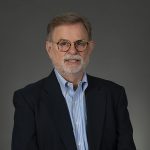 UF Distinguished Professor, TESI Director, & Curator of Vertebrate Paleontology
UF Distinguished Professor, TESI Director, & Curator of Vertebrate Paleontology
Florida Museum of Natural History, Thompson Earth Systems Institute (TESI), Gainesville, Florida 32611-2710
bmacfadd@ufl.edu
Professional Preparation
B.S. Cornell University, 1971; M.Ph. 1974; Ph.D. Columbia University, 1976
Short Bio
On the UF faculty since 1977, Bruce is the author of several books and more than 200 peer-reviewed professional articles. He has been a principal investigator on more than 50 external grants, mostly from the National Science Foundation, totaling more than $35 million. A vertebrate paleontologist by training, specializing in fossil mammals, he has been the President of both the Paleontological Society and Society of Vertebrate Paleontology. Bruce teaches courses on vertebrate paleontology and Broader Impacts, and has been the major professor of two dozen UF graduate students.
Current External Funding
2022 to 2025 (estimated), Principal Investigator and Project Director (PI/PD), NSF project 2147625, Integrating AI Machine Learning into the Teaching of Paleontology Using Fossil Shark Teeth in Middle Schools, $1,275,109.
Professional Employment History and Related Appointments
1977 to present. Assistant, Associate, “Full” Curator (professor rank), and now Distinguished Professor; Chair of academic department, Associate Director (dean rank) of Exhibits & Public Programs; currently inaugural Director, Thompson Earth Systems Institute (TESI), University of Florida, Gainesville, FL
2015—2016. Visiting K-12 Scientist, Santa Cruz County (CA) Board of Education (sabbatical)
2009—2010. Program Officer, Lifelong Learning Cluster (EHR, DRL), National Science Foundation, Arlington VA (IPA rotator)
1994. Senior Research Fellow, Fulbright, La Paz, Bolivia (Museo de Historia Natural)
1993. Visiting Scholar, Department of Geology & Geophysics, University of Utah (NSF-funded sabbatical)
1989—1990. Visiting Scientist, Institute for the Study of Continents (INSTOC), Department of Geological Sciences, Cornell University, Ithaca, NY (sabbatical)
1976—1977. Gibbs Instructor, Department of Geology & Geophysics, Yale University, New Haven, CT
Research Interests
 Fossil vertebrates, stable isotopes, and global change, with emphasis on paleobiology, macroevolution, and paleoecology of Neogene mammals (particularly herbivores) of the Americas
Fossil vertebrates, stable isotopes, and global change, with emphasis on paleobiology, macroevolution, and paleoecology of Neogene mammals (particularly herbivores) of the Americas- Diagenesis of fossil bones and teeth, including sharks and edentates
- Informal science education and broader impacts of natural history museums
- K-12 education and outreach
Collection-related Activities
- Field work related to active collection-based research projects in Florida and Nebraska
- Educational outreach to Florida fossil clubs
Courses Taught
BSC 6038; GLY 6932; Broader Impacts of Science on Society
GLY 6932; Vertebrate PaleontologyGraduate Students
Stephanie Killingsworth, M. S. student, Department of Geological Sciences, Sharks and geochemistry
Sean Moran, Ph.D. Candidate, Biology, Faunal transitions across the EOT ( Eocene-Oligocene Transition) in Nebraska
Selected Professional Publications; Books and Articles
Books, single-authored
MacFadden, B. J. 1992. Fossil Horses: Systematics, Paleobiology, and Evolution of the Family Equidae. New York: Cambridge University Press, 369 pp.
MacFadden, B. J. 2019. Broader Impacts of Science on Society. New York: Cambridge University Press, 322 pp.
Peer-reviewed articles, representative
MacFadden, B. J. 1987. Fossil horses from “Eohippus” (Hyracotherium) to Equus: Scaling, Cope’s Law, and the evolution of body size. Paleobiology 12:355-370.
MacFadden, B. J., and T. E. Cerling. 1994. Fossil horses, stable isotopes, and global change. Trends in Ecology and Evolution 9:481-486.
Cerling , T. E., Harris, J. M., MacFadden, B. J., Leakey, M. G., Quade, J., Eisenmann, V., and J. R. Ehleringer. 1997. Global ecological change through the Miocene-Pliocene boundary. Nature 389:153-158. (cited >2K times)
MacFadden, B. J. 2005. Fossil horses—Evidence for evolution. Science 307:1728-1730.
MacFadden, B. J., B. Dunckel. S. Ellis, L. Dierking, L. Abraham-Silver, J. Kisiel, and J. Koke, 2007. Natural history museum visitor’s understanding of evolution. Bioscience 57:875-882.
Pimiento, C., D.J. Ehret, B.J. MacFadden, and G. Hubbell. 2010. Ancient nursery area for the extinct giant shark Megalodon from the Miocene of Peru. PLoS ONE 5:e10552. (80K views)
MacFadden, B. J., L. H. Oviedo, G. Seymour, and S. Ellis. 2012. Fossil horses, orthogenesis, and communicating evolution in museums. Evolution: Education and Outreach. doi 10.1007/s 12052-012-0394-1
MacFadden, B. J. 2013. Dispersal of Pleistocene Equus (Family Equidae) into South America and calibration of GABI 3: Biostratigraphic evidence from Tarija, Bolivia. PLoS ONE 8(3):e59277 (11 pages). doi:10.1371/journal.pone.0059277
MacFadden, B. J. 2017. Vertebrate Paleontology at the Florida Museum of Natural History, University of Florida: The past 60 years of research and education. Bulletin of the Florida Museum of Natural History. 55:51-87.
Ziegler, M. J., P. Antonenko, C. Grant, A. Hastings, B. J. MacFadden, S. Moran, R. Narducci, V. Perez, J. Pirlo, and M. Selba. 2022. Applications of 3D paleontological data at the Florida Museum of Natural History. Frontiers in Earth Science. Special Issue, 3D printing in Geology and Geophysics. https://doi.org/10.3389/feart.2020.600696